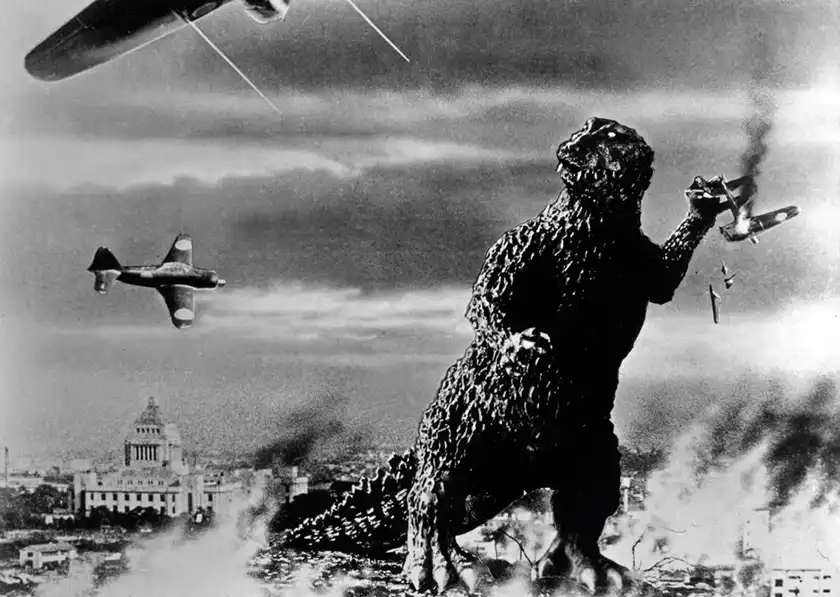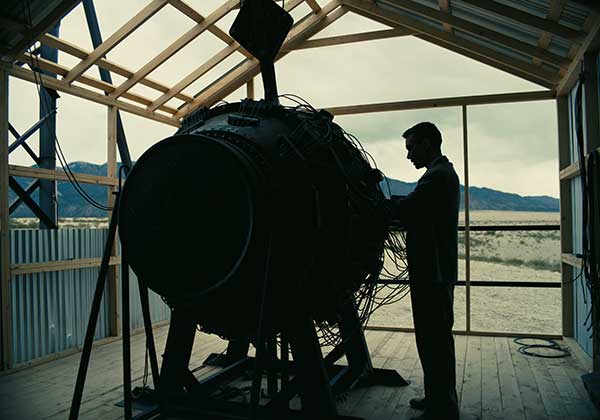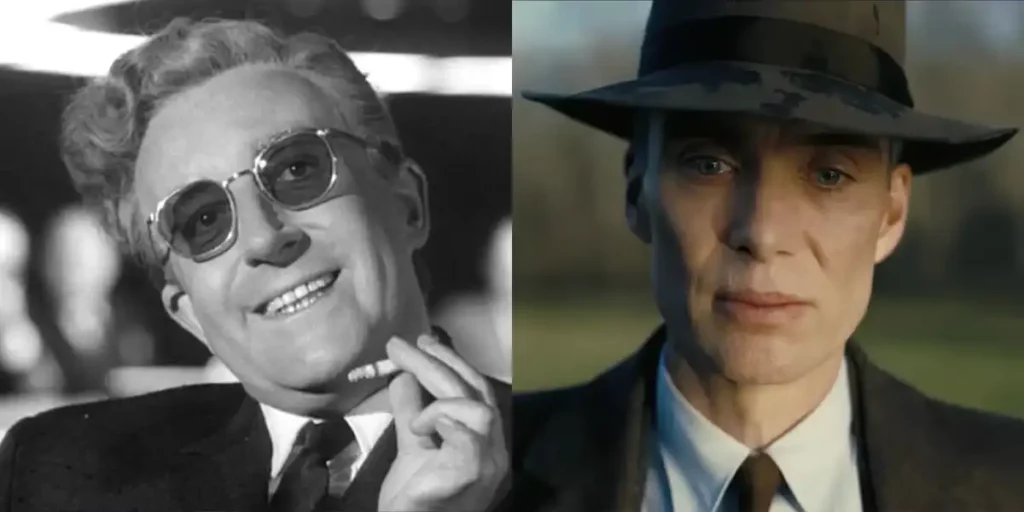From Dr. Strangelove to Oppenheimer, cinema never stopped worrying about the bomb, articulating our fears and worries of nuclear war – and destruction.
If last week’s Oscar nominations announcement proved anything, it’s that Christopher Nolan’s Oppenheimer is the undisputed frontrunner of this awards season. The film about J. Robert Oppenheimer (an outstanding Cillian Murphy) and the seismic invention of the nuclear bomb leads the field with a whopping 13 nods, including Best Picture, Director, Actor, Supporting Actor, Supporting Actress, Cinematography, Editing and Original Score. It is all richly deserved. One of the best movies of 2023, Oppenheimer is an incredible cinematic achievement that confronts the ethics of the race to build atomic weapons. Its success has also been timely, as this month marks the 60th anniversary of another notable movie about them.
Released in the middle of the Cold War (nearly two years after the Cuban Missile Crisis), Stanley Kubrick’s Dr. Strangelove or: How I Stopped Worrying and Learned to Love the Bomb has remained a sharp satire on ineffective nuclear planning. When General Ripper (Sterling Hayden) becomes convinced of an “international Communist conspiracy” to steal bodily fluids, he launches an attack on the USSR. RAF officer Lionel Mandrake, US President Merkin Muffley and Nazi scientist turned adviser Dr. Strangelove (Peter Sellers) are in a race against time to stop it, especially when it becomes apparent a Soviet ‘doomsday device’ will be triggered if just one bomb hits. In the end, everyone is powerless to stop the world from being destroyed. And the memorable final scene – a montage of explosions and mushroom clouds set to Vera Lynn’s ‘We’ll Meet Again’ – forces us to confront that eventuality.
From Strangelove to Oppenheimer, cinema has never stopped worrying about the bomb. Instead, it has consistently articulated our fears of nuclear war and warned us of destruction across multiple decades. Some of these films have demonstrated how close we can or might come to destruction. Others have used terrifying imagery for us to confront the consequences. All of them reflect the anxieties of the world regarding the A-bomb.
Ishirō Honda’s kaiju classic Godzilla (which turns 70 later this year) symbolised the devastation of Hiroshima and Nagasaki at the end of World War II through its titular monster, awakened by hydrogen bomb testing and using his atomic breath to wreak havoc in Tokyo. Notably, one character has developed something “as powerful as a nuclear bomb” to stop Godzilla yet refuses to use it because he fears other nations will want to use it as a superweapon. Even when the monster is defeated, the ending sees a warning that “another Godzilla might appear somewhere in the world” if there is further testing.
As Godzilla has become a pop culture icon, with franchises launched in the US and Japan, the cautionary anti-nuclear message of the original has always been in the background. It was also a major part of last year’s Godzilla Minus One, set in post-WWII Japan (here, Godzilla gains further powers from the real-life testing America did at Bikini Atoll).

The late ‘50s and ‘60s saw disaster movies depicting nuclear dystopias, from The World, the Flesh and the Devil to Planet of the Apes. But none were as realistic as The War Game. Director Peter Watkins presented his scenario as a pseudo-documentary, with a narrator going through the nation’s preparations and the fallout. The BBC produced it for TV but then withdrew it, deeming it “too horrifying for the medium of broadcasting.” It is deliberately so. Handheld camerawork and vox pop interviews with people on the street add a sense of realism to the subsequent burns and firestorms. It shows how ill-prepared we are for the legacy of nuclear war.
With 1970s America characterised by the cooling of international hostilities (and domestic controversies such as Watergate), there were only a few examples of nuclear cinema. But the ‘80s saw the arrival of President Ronald Reagan and a reignition of Cold War tensions. As a reaction to these events, there was a new wave of films on this topic. In WarGames, teenager David Lightman (Matthew Broderick) comes extremely close to starting World War III after hacking into a military supercomputer. Brought in to eliminate human indecisiveness, the War Operation Planned Response (WOPR) almost fools the US chain of command. A misunderstanding brings us to the brink of war, and disaster is only averted when the computer learns of mutually assured destruction. Like in Dr. Strangelove, there is no control over these weapons or the safeguards supposedly in place to save us (this theme is also present in Oppenheimer).
Meanwhile, another ‘80s nuclear film used the same docudrama style as The War Game. This was The Day After, a TV movie that focused on how the nuclear bomb shadows the lives of residents in Kansas and Missouri. More scarily, it ends with a message that what it shows is “less severe than the destruction that would actually occur in the event of a full nuclear strike.” It was so effective that it got through to Reagan, who said The Day After “left me greatly depressed.”
As the 1990s arrived and the Cold War ended, cinema found new ways to include nuclear themes. Joe Dante’s Matinee was set back in 1962 during the Cuban Missile Crisis and centred on how the tense events impacted the town of Key West, Florida (and the opportunistic B-movie producer looking to sell his creature feature). Meanwhile, Broken Arrow and The Peacemaker saw terrorists steal (and threaten to use) nuclear weapons. And in the Jack Ryan thriller The Sum of All Fears, an Austrian Neo-Nazi tries to get America and Russia to destroy each other. Part of his plan involves detonating a warhead in Baltimore, with the film extensively capturing the explosion and aftermath.
Why has cinema highlighted nuclear topics time and time again? Simply put, their prevalence in the public conscience has never dwindled. The issue has never left the political forefront, with relations between America and Russia dictated by their atomic arsenals. Plus, the consequences are obvious: mutually assured destruction, mass fatalities and the end of everything as we know it. This paranoia and worry are universal, and so we turn to a universal medium that captures and externalises those feelings. Perhaps by these films showing what could happen, they can help stop it from happening. That is why Dr. Strangelove has remained important and relevant, and why Oppenheimer has done so well.
Of course, another factor to both films’ successes is that they were made by Kubrick and Nolan, famed auteurs and masters of this craft. With Oppenheimer in particular, Nolan has a domineering score, rumbling sound design, IMAX cameras and stunning practical effects at his disposal. And he uses them to represent the anxieties and sense of dread surrounding the nuclear bomb through the psychological turmoil its creator faced.

Oppenheimer is committed to the Manhattan Project because he rationalises it will lead to a new dawn of peace and international cooperation. Then he sees the US and USSR pit their arsenals against each other. He learns of what happened at Hiroshima and Nagasaki (though he never publicly expresses remorse). Even during his victory speech at Los Alamos, he is plagued by flashes of light and ashy remains at his feet. Those close-ups of a fraught Oppenheimer are as if he was staring into the worrying future he helped to shape. But when he gives these warnings to the public, he is barred from US policymaking.
Dr. Strangelove demonstrates how we have a lack of control over nuclear weapons. Oppenheimer hypothesises that we lost it immediately and have been on the edge of destruction ever since. Both represent the main characteristic of nuclear cinema, which is that they act as cautionary tales for humanity. It is not a coincidence both films end on a despairing note, or that Godzilla and The Day After conclude with warnings about the impact nuclear weapons may have. Or that most of these movies feature a devastating fallout that will linger for years or even decades. The power of nuclear cinema lies in how it shows us the path we are heading towards. And if we all fail to take that message to heart, the end of the world will not just be on the big screen.
Dr. Strangelove and Oppenheimer are now available to watch on digital and on demand. Read our review of Oppenheimer below!

